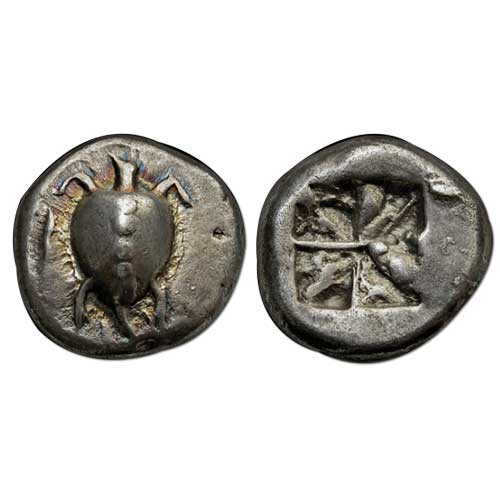Ancient Coins Featuring Turtles
2018-01-12 Fri
Located in the Saronic Gulf about 25 miles southeast of Athens there is a rocky and mountainous island called Aegina. It was settled by the Dorians around 900 BCE and was named after the daughter of the Greek river god Asopos.As there was a scarcity of cultivable land, the inhabitants had to leverage the sea for their livelihood. They became expert merchants and tradesmen and dominated the shipping industry early in the 6th century BC. Their success and near-monopoly brought the island great wealth and power. They built a lavish temple to their local goddess, Aphaia, decorating it with numerous sculptures of beautiful artistic quality.
When they travelled, the merchants encountered the developing early electrum ancient coins in Lonia and Lydia. They not only stored their wealth in the form of portable ancient coins, but also optimized trade through a global currency. Aegina therefore became the first of the Greek city-states to issue coined money, starting in the mid-6th century BCE.
In addition to the silver they received in trade, Aegina worked the mines of the silver-rich island of Siphnos, which were at the height of their production as Aegina was flourishing.
In the 5th and 6th centuries, the emissions from Aegina were substantial, resulting in their weight standard becoming dominant throughout Greece. The Athenians called the Aeginetan drachm the “thick drachm” as it was heavier than that of Athens, with their common didrachm “stater” coinage weighing about 12.6 grams.
The coins spread throughout the world and their status as the first international trade currency was aided by the consistency of their designs.
The earliest types, like this coin, depict a sea turtle engraved in high relief with an incuse pattern on the reverse. The reverse punch changed over time, starting with eight triangles and progressing to a “mill sail”, then a “skew” pattern, to increase the usable duration of the die.
The turtle was used due to their influence as a sea power but perhaps also because the pre-coinage ingots in use in the region were convex in shape and may have been colloquially known as turtles.
ISLANDS off ATTICA, Aegina. Circa 550-530/25 BC. AR Stater (20mm, 12.31 g). Sea turtle, head in profile, with thick collar and row of dots down its back / Deep incuse square of proto-“Union Jack” pattern with eight incuse segments. Meadows, Aegina, Group Ib; Milbank Period I; HGC 6, 425; SNG Copenhagen –; Dewing 1654; Gillet –; Jameson 1198; Pozzi 1618. Near EF, lightly toned. Well centered and struck on a broad flan.
Latest News
-
Mahatma
2024-04-25 ThuIndia Post issued a commemorative postage stamp on #LalaHansraj, also known as Mahatma Hansraj for�...
-
Berar Mint of Muhammad Akbar
2024-04-25 ThuBerar was a kingdom located in the Deccan region, with Elichpur as its capital. It was one of the Su...
-
Janma Kalnayak of Bhagwan Mahavir
2024-04-24 WedOn 21st April 2024 which was the 2550th Janma Kalnyanak of Bhagwan Mahavir Swami, PM Modi unveile...
-
Gold Pagoda of Vijaynagar Empire King Deva Raya I
2024-04-10 WedKing Deva Raya I of the Vijayanagara Empire was a patron of Kannada literature and architecture. He ...
-
Silver Denarius of Septimus Severus
2024-04-05 FriLucius Septimius Severus served as the Roman emperor from 193 to 211 AD. Severus sat on the throne o...

